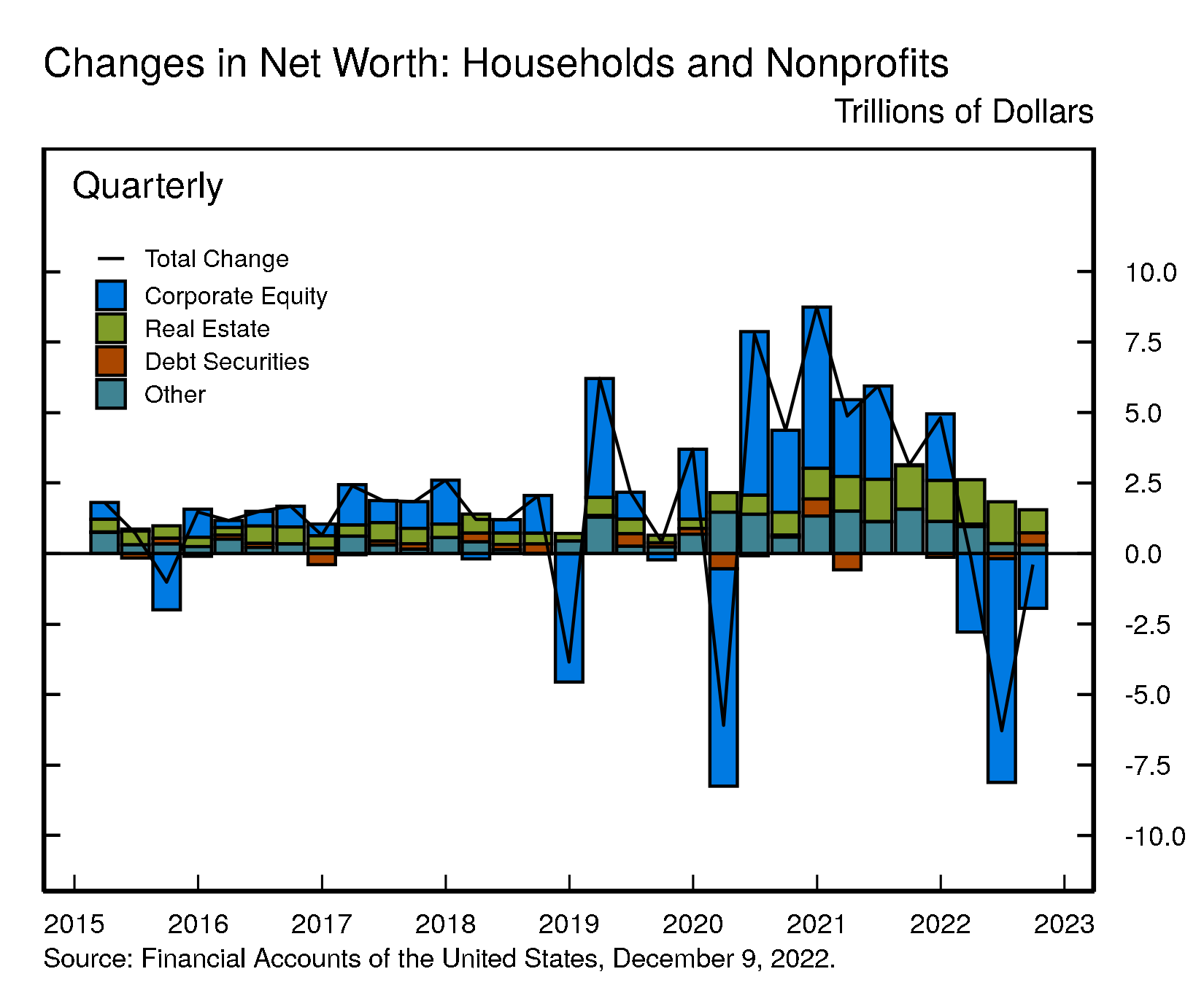Financial Accounts of the United States - Z.1
Recent Developments RSS Data Download
The recent developments discussed below refer to data through September 30, 2022.
- Household net worth decreased by $0.4 trillion in the third quarter, as declines in corporate equity more than offset gains on real estate.
- Household debt grew at an annual pace of 6.3%, reflecting solid growth in both home mortgages and consumer credit.
- Nonfinancial business debt increased at an annual rate of 5.3%, buoyed by an expansion in loans at depository institutions.1
Household Net Worth
The net worth of households and nonprofit organizations declined $0.4 trillion to $143.3 trillion in the third quarter. The value of stocks on the household balance sheet declined by $1.9 trillion, while the value of real estate increased by $0.7 trillion.

View interactive | Accessible version | CSV | Data Dictionary | Chart Note (1) |
Directly and indirectly held corporate equities ($36.7 trillion) and household real estate ($41.9 trillion) were among the largest components of household net worth. Household debt (seasonally adjusted) was $18.8 trillion.

View interactive | Accessible version | CSV | Data Dictionary |
Household Balance Sheet Summary
| Description | 2020 | 2021 | 2021:Q4 | 2022:Q1 | 2022:Q2 | 2022:Q3 |
|---|---|---|---|---|---|---|
| Net Worth | 131.34 | 150.12 | 150.12 | 149.95 | 143.67 | 143.28 |
| Change in Net Worth | 14.80 | 18.78 | 4.82 | -0.17 | -6.28 | -0.39 |
| Equities | 40.97 | 49.40 | 49.40 | 46.62 | 38.68 | 36.74 |
| Change in Equities | 6.72 | 8.43 | 2.36 | -2.78 | -7.94 | -1.94 |
| Real Estate | 33.00 | 38.11 | 38.11 | 39.74 | 41.19 | 41.91 |
| Change in Real Estate | 3.00 | 5.12 | 1.29 | 1.62 | 1.46 | 0.72 |
For more data on household net worth, see table B.101
Nonfinancial debt
Household debt grew by 6.3% in the third quarter of 2022 (this and subsequent rates of growth are reported at a seasonally adjusted annual rate), a bit slower than in the previous quarter. Home mortgage debt expanded 6.6% while nonmortgage consumer credit increased by 7.0%.
Nonfinancial business debt growth stepped down to a 5.3% pace, reflecting subdued corporate bond issuance and robust growth in loans at depository institutions. Federal debt increased by 4.2%, while state and local debt contracted by 0.6%.
The ratio of nonfinancial debt to GDP edged down in the third quarter. The ratio has declined substantially since the third quarter of 2020, when the measure spiked amid a pandemic-induced drop in GDP and the expansion in federal debt related to the fiscal stimulus.
For more data on nonfinancial debt, see table D.1 (rates of growth) and table D.3 (outstanding).
Debt Growth by Sector
| Description | 2020 | 2021 | 2021:Q4 | 2022:Q1 | 2022:Q2 | 2022:Q3 |
|---|---|---|---|---|---|---|
| Total Nonfinancial | 12.45 | 6.31 | 8.82 | 8.34 | 6.49 | 4.86 |
| Households and Nonprofits | 3.84 | 7.38 | 8.08 | 8.25 | 7.37 | 6.26 |
| Nonfinancial Business | 9.20 | 4.96 | 6.96 | 7.84 | 7.74 | 5.33 |
| Federal Government | 24.06 | 7.13 | 12.06 | 10.22 | 5.56 | 4.19 |
| State and Local Governments | 2.93 | 2.17 | -0.98 | -2.83 | 1.61 | -0.58 |
Debt Outstanding by Sector
| Description | 2020 | 2021 | 2021:Q4 | 2022:Q1 | 2022:Q2 | 2022:Q3 |
|---|---|---|---|---|---|---|
| Total Nonfinancial | 61.34 | 65.19 | 65.19 | 66.55 | 67.64 | 68.46 |
| Households and Nonprofits | 16.71 | 17.94 | 17.94 | 18.22 | 18.55 | 18.84 |
| Nonfinancial Business | 17.81 | 18.68 | 18.68 | 19.13 | 19.51 | 19.77 |
| Federal Government | 23.62 | 25.30 | 25.30 | 25.95 | 26.31 | 26.59 |
| State and Local Governments | 3.20 | 3.27 | 3.27 | 3.25 | 3.26 | 3.26 |

Accessible version | CSV | Data Dictionary |

Accessible version | CSV | Data Dictionary |
Looking at the various components of nonfinancial business debt, nonmortgage depository loans to nonfinancial business increased by $65 billion in the third quarter. Other types of loans, including mortgage loans and loans from nondepository institutions, also increased, while corporate bonds outstanding were little changed.
Overall, outstanding nonfinancial corporate debt was $12.8 trillion. Corporate bonds, at roughly $6.7 trillion, accounted for 53% of the total. Nonmortgage depository loans were about $1.5 trillion. Other types of debt include loans from nonbank institutions, loans from the federal government, and commercial paper.
The nonfinancial noncorporate business sector consists mostly of smaller businesses, which are typically not incorporated. Nonfinancial noncorporate business debt was $7.0 trillion, of which $5.0 trillion were mortgage loans and $1.6 trillion were nonmortgage depository loans.

Accessible version | CSV | Data Dictionary |

Accessible version | CSV | Data Dictionary |
For more data on nonfinancial business balance sheets, including debt, see tables B.103 and B.104.
Coming soon
- The Distributional Financial Accounts, which provide a quarterly estimate of the distribution of U.S. household wealth, will be published on Friday, December 16. Other Enhanced Financial Accounts Projects (www.federalreserve.gov/releases/efa/enhanced-financial-accounts.htm) will also be updated on Friday, December 16.
- Financial Accounts data for the fourth quarter of 2022 will be published on Thursday, March 9, 2023, at 12:00 noon.
Chart Notes
- Changes in net worth consist of transactions, revaluations, and other volume changes. Corporate equity and debt securities include directly and indirectly held securities. Real estate is the value of owner-occupied real estate. Other includes equity in noncorporate businesses, consumer durable goods, fixed assets of nonprofit organizations, and all other financial assets apart from corporate equities and debt securities, net of liabilities, as shown on table B.101 Balance Sheet of Households and Nonprofit Organizations.
Depository loans include bank loans (bank credit) and loans from nonbank depository institutions such as credit unions and savings and loans associations.↩